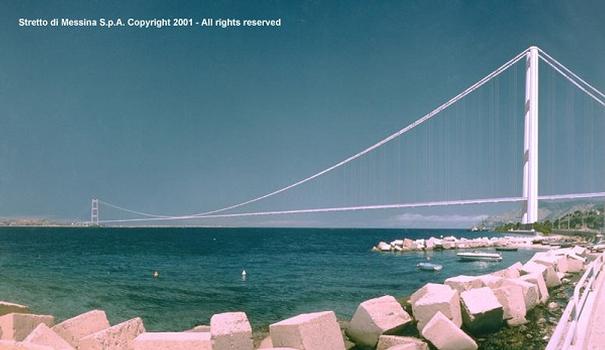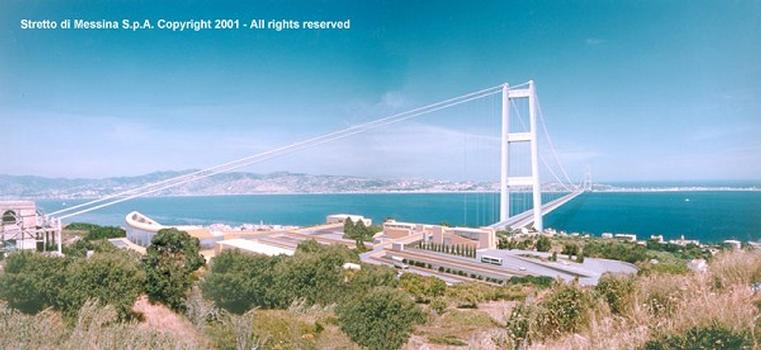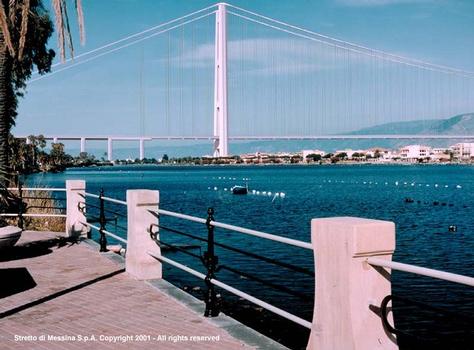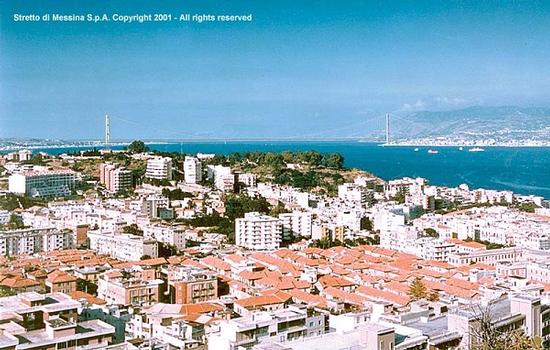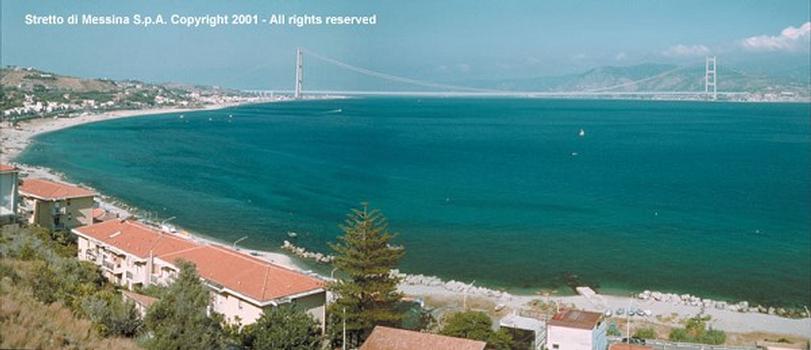General Information
| Name in local language: | Ponte sullo Stretto di Messina |
|---|---|
| Beginning of works: | 2024 |
| Status: | project |
Project Type
| Structure: |
Three-span suspension bridge |
|---|---|
| Support conditions: |
for registered users |
| Function / usage: |
Road bridge Railroad (railway) bridge |
| Material: |
Steel bridge |
| Plan view: |
Structurae Plus/Pro - Subscribe Now! |
Location
| Location: |
Messina, Messina, Sicily, Italy Reggio di Calabria, Calabria, Italy |
|---|---|
| Crosses: |
|
Technical Information
Dimensions
| main span | 3 300 m | |
| total length | 5 070 m | |
| sag:span | 1:11 | |
| span lengths | 183 m - 3 300 m - 183 m | |
| suspended length | 3 666 m | |
| number of spans | 3 | |
| cables | total length | 5 300 m |
| cable diameter | 4 x 1.24 m | |
| number | 4 | |
| deck | deck width | 60.4 m |
| height above valley floor or water | 70.00 m | |
| number of tracks | 2 | |
| number of lanes | 2 x 3 | |
| towers | height | 382.60 m |
Quantities
| towers | structural steel | 2 x 56 000 t |
Design Loads
| wind resistant to | 215 km/h |
Cost
| cost of construction | ca. Euro 4 600 000 000 |
Materials
| deck |
steel
|
|---|---|
| towers |
steel
|
Chronology
| 14 January 2003 | The Board of Directors of Stretto di Messina S.p.A. (Stretto di Messina) approves the Preliminary Project for the Strait of Messina Bridge infrastructure, including the Environmental Impact Study and the Local Urban Planning report. |
|---|---|
| 16 January 2003 | The documentation is sent to the Ministry of Infrastructure, the Ministry of Environment and the Ministry for Cultural Heritage, as well as to the Sicilian and Calabrian Regional Authorities in order to start the procedure provided for in the so called "Legge Obiettivo", a law for public works projects. |
| 28 January 2003 | The Stretto di Messina Extraordinary Shareholders' Assembly unanimously approves the capital increase for a total amount of €2.5 billion, previously agreed on March 18th 2003 by the Board of Directors. |
| 24 April 2003 | The Government passes the Legislative Decree 114 which - in accordance with the special directive contained in Article 14 of Law 166 of August 1st 2002 - updates Law 1158/1971 on the rules governing the permanent road and railway link between Sicily and the Mainland, representing an infrastructure project of major national interest. The Legislative Decree confirms Stretto di Messina is the concessionaire company for the study, design, construction, financing and management of the infrastructure for the permanent link between Sicily and the Mainland (concession already granted in 1985 pursuant to Law 1158 of 1971) and its status as a body governed by public law. |
| 20 June 2003 | The Ministry of the Environment's Special Committee for Environmental Impact Assessment announces their approval of the findings of the Environmental Impact Study for the Strait of Messina Bridge Project and its links. |
| 30 June 2003 | The Strait of Messina Bridge is one of 18 priority projects at European level to be made operational by the year 2020. The list was drawn up by the high level group for the Trans-European Transport Networks (TEN), the Karel Van Miert Group, and set up by the European Commission to identify the priority projects and the major corridors on which the European Partners should focus their attention and investments. |
| 1 August 2003 | The CIPE (Interdepartmental Committee for Economic Planning) approves the Preliminary Project of the Strait of Messina Bridge and its links. |
| 1 October 2003 | Stretto di Messina's Board of Directors resolve to execute the first capital injection of the capital increase for an amount equal to €307 million, as agreed at the Extraordinary Shareholders' Assembly of April 28th. |
| 24 November 2003 | Stretto di Messina and the National Workers Federations, including national, regional and provincial representatives (Fillea Cgil, Filca Cisl and Feneal Uil), agree to a future dialogue for the definition of a Protocol system (see 18 May). |
| 27 November 2003 | An Agreement is signed between the Ministry of Infrastructure, the Ministry of the Economy, the Regions of Calabria and Sicily, Rete Ferroviaria Italiana (RFI), ANAS and Stretto di Messina, defining the technical and financial commitments of each party in the construction and management of the Bridge. |
| 5 December 2003 | The European Ministers of Transport approves the Commission's proposal of October 1st for TEN, which includes the Messina Strait Bridge. |
| 10 December 2003 | The first capital injection of the agreed capital increase is executed. Fintecna, RFI and ANAS subscribe their respective shares. |
| 12 December 2003 | The Council of the European Union approves the "European Action for Growth" plan which includes investments, among others, in the infrastructure sector, such as TEN projects. |
| 16 December 2003 | Stretto di Messina's Board of Directors agree to select only one General Contractor to manage the final project design and the construction works. |
| 22 December 2003 | Fintecna, RFI and ANAS purchase the remaining unsubscribed shares (those allocated for the Calabrian and Sicilian Regional Authorities) and simultaneously deposit the respective amounts, equal to three tenths of the nominal value, in line with the commitment taken at the Shareholders' Assembly of April 28th. |
| 30 December 2003 | The Ministry of Infrastruture and Stretto di Messina signs the new Agreement and Financial Plan. |
| 16 January 2004 | The new Agreement and Financial Plan are approved with the signing of a Decree by the Grantor, the Ministry of Infrastructure, in agreement with the Ministry of the Economy and the Regions of Calabria and Sicily. |
| 25 February 2004 | The Ministry of Infrastructure and Stretto di Messina draw up an additional act to the new Agreement concerning approval procedures for future Financial Plan updates. |
| 15 March 2004 | The additional act to the new Agreement is approved with the signing of a Decree by the Grantor, the Ministry of Infrastructure, in agreement with the Ministry of the Economy. |
| 24 March 2004 | The Board of Directors of Stretto di Messina approves the tender notice to select the General Contractor for the final design and construction of the Bridge. |
| 8 April 2004 | Following registration of interdepartmental decrees on behalf of the State Auditors' Department, the Company sends the tender notice to the Official Italian Gazette and the Official European Gazette. |
|
15 April 2004
— And 16 April 2004 |
The Official Italian Gazette and the Official European Gazette publish the tender notice for the General Contractor. |
| 21 April 2004 | The European Parliament approves on second reading the "European Action for Growth" for investments in the infrastructure sector, such as TEN projects, which include the Strait of Messina bridge. |
| 18 May 2004 | Stretto di Messina and the National Workers Federations, including national, regional and provincial representatives (Fillea Cgil, Filca Cisl and Feneal Uil), sign a Memorandum of Understanding concerning industrial safety and professional training, also aimed at developing employment opportunities in the areas directly affected by the construction of the bridge. This agreement will be applied also to the General Contractor. |
| 3 August 2004 | Stretto di Messina obtaines the Quality Management System Certificate for the standard UNI EN ISO 9001:2000, valid in particular for the preparation of the international tender for the selection of the General Contractor. |
| 15 September 2004 | Five candidates have responded to the tender for the selection of the General Contractor. |
| 16 September 2004 | Stretto di Messina appoints the pre-qualification Commission in charge of assessing, based on the tender notice, the pre-requisites of the five candidates for the selection of the General Contractor. |
| 28 October 2004 | The pre-qualification phase for the selection of the General Contractor is concluded. Based on the results of the pre-qualification Commission, Stretto di Messina sends the invitation to bid to three candidates:
|
| 20 April 2005 | Due date for the reception of offers from the three consortia. For the final award of the tender, Stretto di Messina will appoint an independent Judging Commission which will hold its first meeting on 27 April, 2005. |
| 12 October 2005 | Selection of General Contractor, a consortium lead by Impregilo, whose first task is the final design draft. |
| 11 October 2006 | The Italian parliament stops the project. |
| 23 December 2009 | Official beginning of construction for preparatory works including the diversion of the Tyrrhenian railway at Cannitello on the Italian mainland. Completion of the overall project was expected in 2016. |
| 29 July 2011 | The board of Stretto di Messina S.p.A. approves the final project. Beginning of construction of the actual bridge is announced for the middle of 2012. A government commission's necessary approval is expected for February 2012, however the end of Berlusconi's government on 9 November 2011 and the following change of government prevent the commission from doing so. |
| 1 March 2013 | A law passed by the Italian parliament in December 2012 requires the signing of an additional contract between the bridge company and the contractor by this day in order to proceed with the project. As the contract is not signed the bridge company is put into liquidation on 15 April 2013 |
| 16 March 2023 | The Italian Government under Gieorgia Meloni and Matteo Salvini headint the Ministry of Infrastructure, approves a decree law to proceed with the construction of the Messina Straits Bridge. Works could begin as early as 2024. |
Notes
If built, the bridge would have a main span that surpasses by more than 1.3 km the currently longest spanning bridge, the Akashi Kaikyo Bridge. This would be an increase of roughly 65%. As it is meant to be a combined road and rail bridge, it would surpass the next longest bridge for the same use, the Tsing Ma Bridge, by nearly 2 km.
The greatest problem in designing the bridge is the aerodynamic stability of the deck under wind as well as seismic activity. A three-part box girder section was designed for the deck with the middle box carrying two railroad tracks and the outer boxes carrying the vehicular traffic. The three sections are connected by diaphragms at regular intervalls corresponding to the position of the hangers. The latter connect to a pair of main cables on each side of the deck.
Participants
Relevant Web Sites
Relevant Publications
- (1982): Die 400 m hohen Betonpylone der projektierten Hängebrücke über die Meerenge von Messina. In: Bautechnik, v. 59, n. 11 (November 1982), pp. 380-382.
- (1993): The aerodynamic design of the Messina Straits Bridge. In: Journal of Wind Engineering and Industrial Aerodynamics, v. 48, n. 2-3 (October 1993), pp. 395-409.
- (2011): Aerodynamics of the Messina Bridge Deck Progetto Definitivo. Presented at: 35th Annual Symposium of IABSE / 52nd Annual Symposium of IASS / 6th International Conference on Space Structures: Taller, Longer, Lighter - Meeting growing demand with limited resources, London, United Kingdom, September 2011.
- (2002): Bridges - Ponts - Brücken. Atrium, Mexico City (Mexico), pp. 268-272.
- (2008): Come si realizza il ponte di Messina. In: Strade e Autostrade, v. 12, n. 70 (July 2008), pp. 98.
- About this
data sheet - Structure-ID
20004265 - Published on:
13/07/2002 - Last updated on:
28/03/2023

